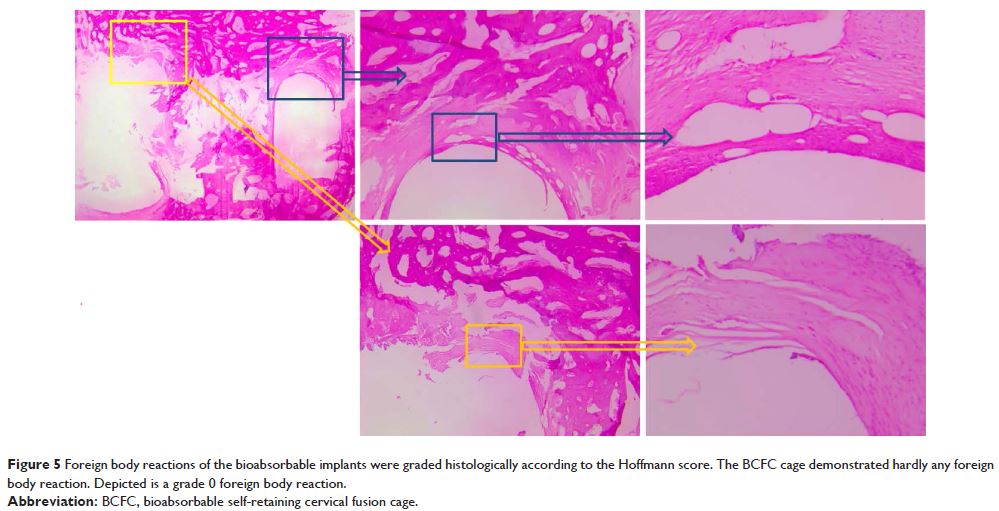100205
论文已发表
注册即可获取德孚的最新动态
IF 收录期刊
- 3.3 Breast Cancer (Dove Med Press)
- 3.4 Clin Epidemiol
- 2.5 Cancer Manag Res
- 2.9 Infect Drug Resist
- 3.5 Clin Interv Aging
- 4.7 Drug Des Dev Ther
- 2.7 Int J Chronic Obstr
- 6.6 Int J Nanomed
- 2.5 Int J Women's Health
- 2.5 Neuropsych Dis Treat
- 2.7 OncoTargets Ther
- 2.0 Patient Prefer Adher
- 2.3 Ther Clin Risk Manag
- 2.5 J Pain Res
- 2.8 Diabet Metab Synd Ob
- 2.8 Psychol Res Behav Ma
- 3.0 Nat Sci Sleep
- 1.8 Pharmgenomics Pers Med
- 2.7 Risk Manag Healthc Policy
- 4.2 J Inflamm Res
- 2.1 Int J Gen Med
- 4.2 J Hepatocell Carcinoma
- 3.7 J Asthma Allergy
- 1.9 Clin Cosmet Investig Dermatol
- 2.7 J Multidiscip Healthc

山羊模型中生物可吸收自支撑 PLA /纳米级 β-TCP 颈椎椎间融合器:体内研究
Authors Cao L, Chen Q, Jiang LB, Yin XF, Bian C, Wang HR, Ma YQ, Li XQ, Li XL, Dong J
Received 9 January 2017
Accepted for publication 2 May 2017
Published 3 October 2017 Volume 2017:12 Pages 7197—7205
DOI https://doi.org/10.2147/IJN.S132041
Checked for plagiarism Yes
Review by Single-blind
Peer reviewers approved by Dr Colin Mak
Peer reviewer comments 3
Editor who approved publication: Dr Lei Yang
Study design: This is an experimental animal study.
Objective: The objective of this study was to compare an
anterior cervical discectomy and interbody fusion of a novel
polylactide/nano-sized β-tricalcium phosphate (PLA/nβ-TCP) bioabsorbable
self-retaining cervical fusion cage (BCFC) with an autologous bone graft and
polyetheretherketone (PEEK) cages.
Background: Although PLA cervical cages have potential advantages
compared with traditional materials, they are not currently routinely used in
spine surgery because of undesirable effects such as the lack of
osteoconductivity and osteolysis around the implant. This study involved the
manufacturing of a bioabsorbable cage from PLA/nβ-TCP that was then used as a
device for anterior cervical discectomy and fusion (ACDF) on a goat cervical
spine fusion model.
Materials and methods: Eighteen goats underwent C3/C4 discectomy and
were randomly divided into three groups based on the following methods: Group A
(n=6), an autologous bone graft; Group B (n=6), PEEK cage filled with an
autologous graft; and Group C (n=6), BCFC filled with an autologous iliac bone.
Radiography was performed preoperatively and postoperatively and at 1, 4, 8,
and 12 weeks after the operation. Disc space height (DSH) was measured at the
same time. After 12 weeks, the fused segments were harvested and evaluated with
functional radiographic views, biomechanical testing, and histological
analyses.
Results: Over a 12-week period, the BCFC and PEEK cage groups
exhibited significantly higher DSH values than the bone graft group. Additionally,
the BCFC group yielded a significantly lower range of motion in axial rotation
than both the autologous bone graft and PEEK cage groups. A histologic
evaluation revealed an increased intervertebral bone volume/total volume ratio
and better interbody fusion in the BCFC group than in the other groups.
Conclusion: The BCFC device exhibited better results than the
autologous bone graft and PEEK cages in single-level ACDF models in vivo. This
device may be a potential alternative to the current PEEK cages.
Keywords: goat, cervical
spine cages, bioabsorbable, PLA, β-TCP, self-retaining
